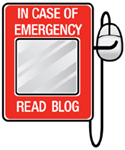Whenever there is a fire in Los Angeles, I am immediately informed. In fact, whenever the Los Angeles Fire Department (LAFD) responds to a major incident —  a traffic accident, helicopter rescue, a mudslide or whatever – I receive notification. So why does LAFD alert a civilian who is 2500 miles away in the middle of New York City? Because I asked.
The LAFD is one of the growing number of governmental authorities that are offering citizens the opportunity to sign up for informational alerts. Because I am researching this topic I have signed up for a number of them around the nation even if it they don’t have practical relevance to me. It is fascinating to see these develop throughout the country as authorities experiment with new communications technology.
If you are interested in signing up for these alerts in your area, you should probably first check the emergency management websites of your local and state government. It is possible that there is not an alert available yet where you are. But it is likely that one is at least being discussed or developed. The LAFD is very much ahead of the curve on this, and most uniformed first responder services do not yet have this service.
If you live in Los Angeles or are interested in seeing this:
http://groups.google.com/group/LAFD_ALERT
Here in New York State, an email/text program, NY Alert, has recently been launched. John Gibb, the Director of New York State’s Emergency Management office, told me in Albany recently that in the first month one million of the possible 19 million users have already signed up. It points out the great interest from the public in receiving emergency information. At present, all these systems are in their infancy and have somewhat limited impact, but the potential is huge.
The City of New York has just launched its alert system, NotifyNYC, in four pilot communities and will be expanding it soon.
http://www.nyc.gov/html/notifynyc/html/home/home.shtml
The transportation area is also where public alerts are being used. Many state and local highway systems offer email or text information regarding traffic and construction. Mass transit is another interesting example, including the Washington Metro subway system which offers alerts on delayed trains among other incidents.Â
http://www.wmata.com/riding/alerts/metrorail_alerts.cfm
On a national level, the FBI has expanded its email alert system which covers many of its responsibilities, including terrorist alerts:




3 responses so far ↓
1 Just Two Hours After ‘Warning’ Earthquake, L.A. Fire Department Seizes Moment To Promote Citizen Preparedness // Jul 29, 2008 at 9:50 pm
[...] email/text message list. But I am not surprised that LAFD acted so quickly and directly, since as I have mentioned before, the Department is a (if not ‘the’) leader in government Preparedness 2.0 [...]
2 Wireless Foundation Launches New Website With Very Useful & Simple Tips For Using Your Cell Phone/PDA In An Emergency — Government Preparedness Web Sites Should Add Them Immediately // Aug 18, 2008 at 7:14 am
[...] makes getting this information into people’s hands and phones even more important. Further, as cities and states increasingly develop email and text emergency alerts for their citizens, they need to better explain the great potential (and the limitations) of their personal [...]
3 “A Gov 2.0 Pioneer”: The Los Angeles Fire Department’s Brian Humphrey Was Using Social Media Before Social Media Was Cool // Jun 7, 2010 at 11:32 am
[...] left) is a veteran Los Angeles Fire Department (LAFD) public information officer who has made the LAFD a leader in the use of governmental social media, particularly in the area of emergency communications. [...]
Leave a Comment